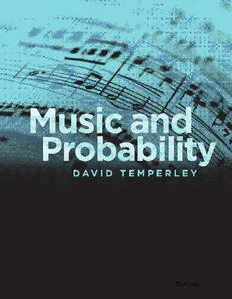
Music and probability PDF
Preview Music and probability
Temperley_jkt.qxd 11/28/06 6:57 AM Page 1 COMPUTER MUSIC T E M P E R L E Y DAVID TEMPERLEY InMusicandProbability,DavidTemperleyexplores issuesinmusicperceptionandcognitionfromaprob- abilisticperspective.Theapplicationofprobabilistic ideastomusichasbeenpursuedonlysporadically overthepastfourdecades,butthetimeisripe, Temperleyargues,forareconsiderationofhowproba- bilitiesshapemusicperceptionandevenmusicitself. Recentadvancesintheapplicationofprobabilitythe- orytootherdomainsofcognitivemodeling,coupled withnewevidenceandtheoreticalinsightsaboutthe workingofthemusicalmind,havelaidtheground- DAVID TEMPERLEY isAssociateProfessorof “Temperleyhasmadeaseminalcontributiontotheemergingfieldsofempiricaland workformorefruitfulinvestigations.Temperleypro- MusicTheoryattheEastmanSchoolofMusic, cognitivemusicology. Probabilisticreasoningprovidesthegluethatattachestheory posescomputationalmodelsfortwobasiccognitive UniversityofRochester,andtheauthorof todata. Temperley,anaccomplishedandimaginativemusictheorist, knowsthedata processes,theperceptionofkeyandtheperception TheCognitionofBasicMusicalStructures ofmusictowhichhelucidlyappliesprobabilisticmodelingtechniques. Theemphasis D AV I D T E M P E R L E Y ofmeter,usingtechniquesofBayesianprobabilistic (MITPress,2001). isonBayesianmethodsandtheresultisafirmempiricalgroundingformusictheory.” modeling. Drawingonhisownresearchandsurvey- —DavidWessel,ProfessorofMusic,UniversityofCalifornia,Berkeley ingrecentworkbyothers,Temperleyexploresarange offurtherissuesinmusicandprobability,including “Temperley’sbookistimelyandwillbeamajorcontributiontothefieldofmusic transcription,phraseperception,patternperception, cognition.Thescholarshipissoundandtheresearchoriginal.Itisgratifyingtosee harmony,improvisation,andmusicalstyles. suchfirst-ratework.” MusicandProbability—thefirstfull-lengthbookto —DavidHuron,ProfessorofMusic,OhioStateUniversity,andauthorofSweet exploretheapplicationofprobabilistictechniquesto Anticipation:MusicandthePsychologyofExpectation musicalissues—includesaconcisesurveyofprobability theory,withsimpleexamplesandadiscussionofits applicationinotherdomains.Temperleyreliesmost TheMITPress heavilyonaBayesianapproach,whichnotonlyallows MassachusettsInstituteofTechnology himtomodeltheperceptionofmeterandtonalitybut Cambridge,Massachusetts02142 alsoshedslightonsuchperceptualprocessesaserror http://mitpress.mit.edu detection,expectation,andpitchidentification. Bayesiantechniquesalsoprovideinsightsintosuch 0-262-20166-6 978-0-262-20166-7 subtleandadvancedissuesasmusicalambiguity, tension,and“grammaticality,”andleadtointeresting andnovelpredictionsaboutcompositionalpractice TEAM LinG anddifferencesbetweenmusicalstyles. Music and Probability TEAM LinG TEAM LinG Music and Probability David Temperley TheMIT Press Cambridge,Massachusetts London, England TEAM LinG (2007MassachusettsInstituteofTechnology Allrightsreserved.Nopartofthisbookmaybereproducedinanyformbyany electronic ormechanical means (including photocopying, recording, or informa- tionstorageandretrieval)withoutpermissioninwritingfromthepublisher. MITPressbooksmaybepurchasedatspecialquantitydiscountsforbusinessor sales promotional use. For information, please email [email protected] .edu or write to Special Sales Department, The MIT Press, 55 Hayward Street, Cambridge,MA02142. This book was set in Sabon on 3B2 by Asco Typesetters, Hong Kong, and was printedandboundintheUnitedStatesofAmerica. LibraryofCongressCataloging-in-PublicationData Temperley,David. Musicandprobability/DavidTemperley. p. cm. Includesbibliographicalreferencesandindex. Contents:Probabilisticfoundationsandbackground—MelodyI:therhythm model—MelodyII:thepitchmodel—Key-findinginpolyphonicmusic— Applicationsofthepolyphonickey-findingmodel—Bayesianmodelsofother aspectsofmusic—Styleandcomposition—Communicativepressure. ISBN-13:978-0-262-20166-7(hc:alk.paper) ISBN-10:0-262-20166-6(hc:alk.paper) 1.Musicalperception—Mathematicalmodels. 2.Musicandprobability. I.Title. ML3838.T46 2007 781.2—dc22 2006046159 10 9 8 7 6 5 4 3 2 1 TEAM LinG Formy parents TEAM LinG TEAM LinG Contents Preface ix 1 Introduction 1 2 Probabilistic Foundations and Background 7 2.1 Elementary Probability 7 2.2 Conditional Probability and Bayes’Rule 8 2.3 Other Probabilistic Concepts 14 2.4 EarlyWork on Music and Probability 19 3 Melody I:The Rhythm Model 23 3.1 Rhythm and Meter 23 3.2 Previous Models of Meter Perception 26 3.3 A Probabilistic Rhythm Model 30 3.4 The Generative Process 31 3.5 The Meter-Finding Process 36 3.6 Testing the Modelon Meter-Finding 41 3.7 Problems and Possible Improvements 43 4 Melody II: ThePitch Model 49 4.1 Previous Models of Key-Finding 50 4.2 The Pitch Model 56 4.3 Testing the Modelon Key-Finding 62 5 Melody III: Expectation and ErrorDetection 65 5.1 Calculating the Probability of a MelodicSurface 65 5.2 Pitch Expectation 66 5.3 Rhythmic Expectation 71 TEAM LinG 5.4 ErrorDetection 74 5.5 FurtherIssues 76 6 APolyphonic Key-FindingModel 79 6.1 A Pitch-Class-Set Approach to Key-Finding 79 6.2 The Generative Process 83 6.3 The Key-Finding Process 85 6.4 Comparing Distributional Models of Key-Finding 89 6.5 FurtherIssues inKey-Finding 92 7 Applications of the PolyphonicKey-Finding Model 99 7.1 Key Relations 99 7.2 Tonalness 108 7.3 Tonal Ambiguity and Clarity 116 7.4 AnotherLook atMajorand Minor 121 7.5 Ambiguous Pitch-Collections inCommon-Practice Music 125 7.6 Explaining Common Strategies of Tonal Harmony 131 8 Bayesian Models of Other Aspectsof Music 139 8.1 ProbabilisticTranscriptionModels 139 8.2 Bod: ThePerceptionof Phrase Structure 143 8.3 Raphaeland Stoddard: HarmonicAnalysis 147 8.4 Mavromatis:Modeling Greek Chant Improvisation 151 8.5 Saffran etal.:Statistical Learning of Melodic Patterns 156 9 Style and Composition 159 9.1 SomeSimple Cross-Entropy Experiments 161 9.2 Modeling Stylistic Differences 166 9.3 Testing Schenkerian Theory 172 10 Communicative Pressure 181 10.1 Communicative Pressure in Rules of Voice-Leading 182 10.2 The Syncopation-Rubato Trade-Off 184 10.3 Other Examples of Communicative Pressurein Rhythm 191 10.4 ‘‘TradingRelationships’’ 197 10.5 Low-Probability Eventsin Constrained Contexts 202 10.6 Conclusions 205 Notes 209 References 225 Author Index 237 Subject Index 241 viii Contents TEAM LinG Preface The story of this book really begins in early 2001, when I was finishing up my first book, The Cognition of Basic Musical Structures (CBMS), and looking around for something new to work on. While satisfied with CBMS in many ways, I had certain nagging doubts about the project. CBMS—a computational study of basic aspects of music perception— employedtheapproachofpreferencerules,inwhichmanypossibleanal- yses are considered and evaluated using a set of criteria. Although it has manyvirtues,thepreferenceruleapproachseemedtohavefewadherents beyond myself and a few others in music theory and linguistics. This troubled me; if so many aspects of music cognition (meter, harmony, andthelike)reflected‘‘preference-rule-like’’mechanisms,whyweresuch mechanismsnotwidelyfoundinotherdomainsofcognition,suchaslan- guage and vision? I was also troubled by the seemingly ad hoc and arbi- trarynatureofthepreference-ruleapproach.Onecoulddevelopamodel by adding rules and tweaking their parameters in a trial-and-error fash- ion, but there didn’t seem to be any principled basis for making these decisions. At the same time—2001 or so—I was becoming increasingly inter- ested in work in computational linguistics. In particular, I was intrigued by the progress that had been made on the basic linguistic problem of syntactic parsing. Computational models were now being developed that could take real-world text and derive syntactic structure from it with high rates of accuracy—an achievement that had hitherto been completely out of reach. These new computational models all involved probabilistic, and in particular Bayesian, methods. Having worked on TEAM LinG
